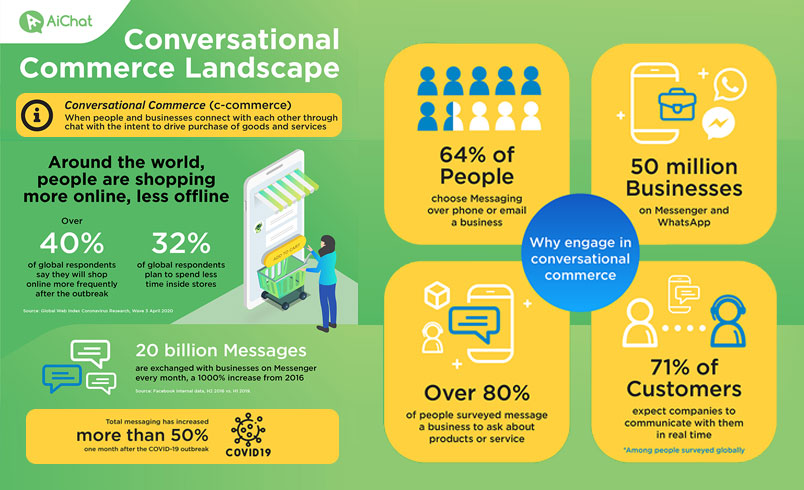The current times are still fogged with uncertainty and apprehension. Naturally, a global census indicates a shift of over 40% increase of online shopping behavior since the COVID-19 outbreak as we witness brands expedite their plans to optimise the online shopping experience and offerings.
The Acceleration of Conversational Commerce adoption in pandemic times (Infographic)
October 25, 2020

October 25, 2020
Unprecedented as it is, this shift isn’t foreign at all. The rise of social media channels and e-commerce giants, as well as the cohesive nature of both forming an ecosystem of sales cycles, have been around for years. So is chat, from calls to emails to live chat – these have been common features adopted by brands to enhance customer experience. What has changed then?
Conversational Commerce, or what’s known as c-commerce, encompasses interactions when people and businesses connect through chat, with the intent to drive purchase of goods and services. Here are a few points that stick out in this definition:
1. Chat vs Others
Previous means of communication (calls, email, etc) have also been involved in providing product information and sales conversions. However, the term Conversational Commerce was only coined by Uber’s Chris Messina in 2015 to exclusively highlight the impact of messaging platforms and more importantly, the advent of chatbots and how human and bot collaboration is crucial in ensuring the chat to conversion effect.
2. Chat Intention
What was conventionally a means of leaving feedback or getting basic information on products and services has evolved into one that functions as well as another lead generation or sales touchpoint. The gravity of missing a chat would now mean potentially missing a sale or a returning customer. That coupled with the growth of messaging to 20 billion messages (and growing) exchanged between consumers and businesses every month, speaks volumes.
Herein, we’ve collated some of the most salient statistics around this rising trend. As expected, with online shopping growing exponentially in the Southeast Asian region, conversational commerce has matching adoption rates in the region given the prevalent skip to Web 2.0 in most markets with mobile-first and social media driven initiatives.

Recent Posts
- The Future of Customer Support: Harnessing Generative AI for Better Customer Service
- Best Practices for Success with Your Marketing Messages This Festive Season
- Transform Your Marketing Strategy with WhatsApp Broadcasting: A Guide to Customer Engagement
- The Role of AI Chatbots in Revolutionizing Healthcare
- 6 AI Strategies to Boost Retail Customer Loyalty
Categories
- Careers
- Conversational Advertising
- Conversational AI
- Conversational Commerce
- Conversational Marketing
- Conversational Service
- Customer Experience
- Customer Service
- Generative AI
- Google Business Messages
- Healthcare
- Hospitality
- Insights
- Marketing
- Press Release
- Security
- SMEs
- Technology
- WhatsApp Business

